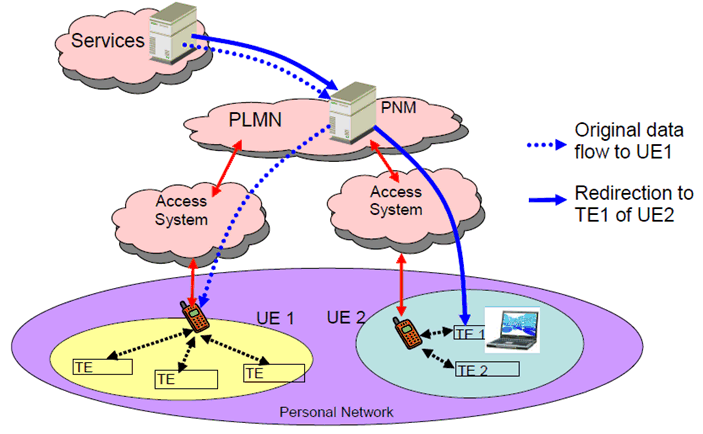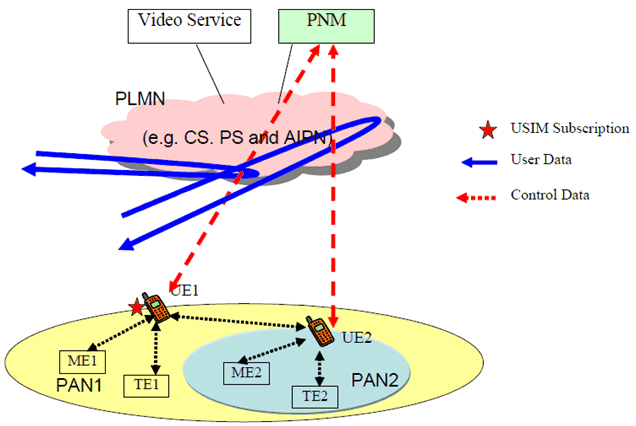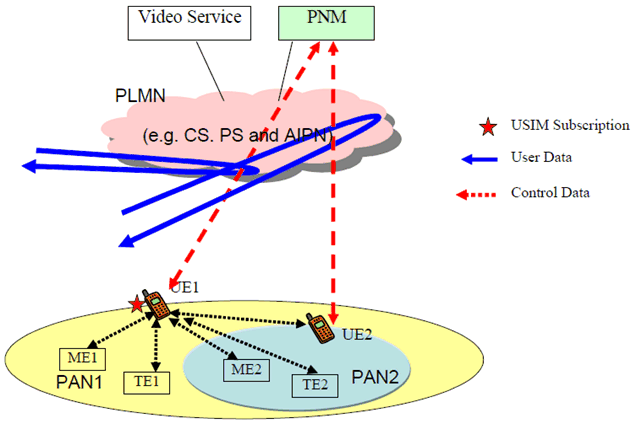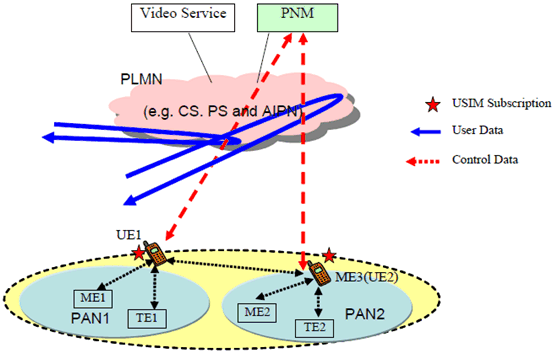Content for TS 22.259 Word version: 18.0.1
A.6 Use case on PNE redirection of terminating services
A.7 Use case: Selective update based on capability lists
A.8 Use case: Combination of two PANs
A.9 Use case: Separation of PAN
$ Change history
A.6 Use case on PNE redirection of terminating services p. 22
An advanced user does not only possess a number of different devices with 3GPP access for various purposes like a multimedia phone with advanced camera and music capabilities, a car phone with car specific features, or a smart phone with messaging and internet. The advanced user is interested in local connectivity between these devices and with other owned devices like a PDA and notebook. For instance, a user may be on a business tour with the car. The car has an in-built car phone. The user wants to utilize the 3GPP access of the car phone in order to terminate network services with the notebook. For this purpose the user sets up a local network between notebook and car phone. In this scenario the car phone provides the MT capabilities and the notebook acts as TE of the UE. With the PN UE redirection the user would only be able to redirect terminating services to the car UE. The TE device would not be known and visible to the PLMN routing. The user would have to configure the local network to achieve the proper forwarding and processing within the local network. Instead of complicated manual settings the user wants a simple natural method as provided by the PN UE Redirecting application. The user starts the notebook. Automatically the car phone is detected and a local connection with the car phone is established. Afterwards the user presses a software button for terminating all or selected services on the notebook. This should work independently of the radio access means available for the access to the 3GPP system. For example the notebook may have own radio access means. After activation of the notebook for service termination the radio access means do not matter. Independent of the radio access technology and possibly simultaneous connections to the 3GPP system the chosen services are always directed to the notebook.

Figure 12: Activating a particular device of a UE or PAN for service termination
(⇒ copy of original 3GPP image)
(⇒ copy of original 3GPP image)
A.7 Use case: Selective update based on capability lists p. 23
Alice has a home PAN or UE where her video device (sink) has been registered as a PNE at the PNM. Alice is traveling to her office, and has registered her UE to the PN. For all video services she has chosen her video device as the terminating device, where it can be recorded for future viewing. She has also requested the PN service to update her on PN settings based on the service she is interested in (video devices, audio devices, printing devices, other services). For some reason, her video device (TE) becomes unavailable (Eg: power goes down or switched off by somebody else or network down.etc). The home PAN or UE deactivates this video device (TE) and makes the PN service aware of this deactivation. The PN service then lets Alice know of this event based on the capability list she has chosen.
As an effect, Alice after receiving this update may change her video terminating settings to her own UE.
A.8 Use case: Combination of two PANs p. 23
Figure 13 and Figure 14 describe the PNM functionality on combination of two PANs. When PAN1 and PAN2 are physically close to each other, the user may hope to combine them into one PAN and designate UE1 as the new PAN's UE. The PNM needs to deactivate UE2 and update relative registration information (binding tables and addresses) of UE1 and PNEs in PAN2. The PNEs in PAN2 (ME2 and TE2) may keep or change the original network positions, i.e. the connection to UE2 or UE1 (described as case 1 and case 2). After the combination UE2 and ME2 need to be authorized through UE1 to get access for any new service, and then they can access those services directly.


A.9 Use case: Separation of PAN p. 25
Figure 15 describes the PNM functionality on separation of PAN. It's very likely to happen that some devices in a PAN move far away and almost out of control, or even they are not so far away but the user wants to separate them into two PANs. In this use case the user want to separate ME2, TE2 and ME3 from the PAN and to form a new PAN (PAN2). The PNM shall designate a UE for PAN2, i.e. activate a ME (ME3) who contains a USIM. The PN shall update registration information of ME3 (UE2), ME2, TE2 and UE1 due to the changes of network positions. And the PNEs in PAN2 including UE2 need to get authorized through the USIM on UE2 for new services provided by PLMN.
